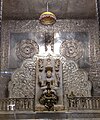|
Padmavati (Jainism)
Padmāvatī is the protective goddess or śāsana devī (शासनदेवी) of Pārśvanātha, the twenty-third Jain tīrthāṅkara, complimenting Parshwa yaksha in Swetambara and Dharanendra in digambar the shasan deva.[1] She is a yakshini (attendant goddess) of Parshwanatha.[2] Jain biographyThere is another pair of souls of a nāga and nāginī who were saved by Parshwanath while being burnt alive in a log of wood by the tapas kamath, and who were subsequently reborn as Indra (Dharanendra in particular) and Padmavati (different from sashan devi) after their death.[3] According to the Jain tradition, Padmavati and her husband Dharanendra protected Lord Parshvanatha when he was harassed by Meghmali.[4][5] After Padmavati rescued Parshvanatha grew subsequently powerful in to yakshi, a powerful tantric deity and surpassed other snake goddess Vairotya.[6] LegacyWorship Goddess Padmavati along with Ambika and Chakreshvari are held as esteemed deities and worshipped by Jains along with tirthankaras.[7][8] Ambika and Padmavati are associated with tantric rituals. Both Padmavati and Dharanendra are revered exclusively as powerful intercessor deities.[1] These tantric rites involves yantra-vidhi, pitha-sthapana and mantra-puja.[9][6] Friday of every week is a particularly popular day to worship the Goddess.[10] In literature
IconographyA snake's hood covers her head, and she sits on a lotus flower. Often a small image of Parshvanatha is placed in her crown. She may be depicted as four-armed, carrying noose and rosary (japa mala), elephant goad, lotus and a fruit.[4] Her mount, or vahana, is the rooster.[12] Yaksha-Yakshi pair sculptures of Padmavati Ambika and Dharanendra are one of the most favoured along with Gomukha-Chakreshwari and Sarvahanabhuti-Ambika.[13]
Main temples
See alsoReferencesCitation
Source
External links
|
|||||||||||||||||||||||
Portal di Ensiklopedia Dunia










